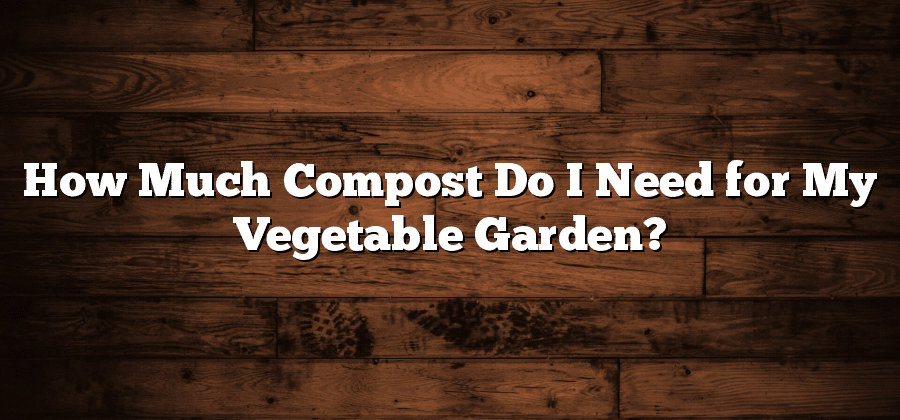Calculating the Required Amount of Compost for Your Vegetable Garden
One of the key considerations when planning and preparing your vegetable garden is determining the required amount of compost. Compost is a rich source of nutrients that will help your plants grow and thrive. Calculating the right amount of compost is crucial to ensure optimal plant health and productivity.
To begin, you need to evaluate the size and layout of your garden. This will help you determine the total area that needs to be covered with compost. Measure the length and width of the garden to calculate the square footage. Additionally, consider any raised beds or containers that may require compost. These measurements will provide you with the basic information needed to calculate the amount of compost required. As a general rule of thumb, it is recommended to apply compost at a thickness of 2-3 inches for vegetables. However, this can vary depending on the specific needs of your plants and the quality of your existing soil.
Determining the Optimal Compost-to-Soil Ratio
When it comes to determining the optimal compost-to-soil ratio for your vegetable garden, there are a few key factors to consider. Firstly, you need to assess the nutrient content of your soil and determine if it lacks any essential elements for plant growth. Compost can provide a rich source of organic matter and nutrients, but it is important not to overdo it. The ideal ratio for most vegetable plants is around 20-30% compost to 70-80% soil.
Another important consideration is the type of vegetables you are planning to grow. Different plants have varying nutrient requirements, and this can impact the compost-to-soil ratio. For example, leafy greens like spinach and lettuce require higher nitrogen levels, while root vegetables like carrots and potatoes thrive with a more balanced ratio. Understanding the specific needs of your vegetable plants will help you determine the ideal compost-to-soil ratio for optimal growth and productivity in your garden.
By carefully assessing the nutrient needs of your plants, as well as the current state of your soil, you can determine the ideal compost-to-soil ratio for your vegetable garden. Remember that compost is a valuable resource, but excessive use can lead to nutrient imbalances and potential issues with plant health. Finding the right balance will help ensure that your plants receive the necessary nourishment for healthy growth and a bountiful harvest.
Understanding the Nutrient Needs of Your Vegetable Plants
To ensure the healthy growth and productivity of your vegetable plants, it is crucial to understand their nutrient needs. Each plant requires a specific blend of nutrients in order to flourish and produce high-quality crops. Macronutrients such as nitrogen, phosphorus, and potassium are essential for plant growth, while micronutrients like iron, zinc, and manganese are needed in smaller quantities.
One way to determine the nutrient needs of your vegetable plants is by conducting a soil test. This test will provide valuable information about the existing nutrient levels in your soil, allowing you to make informed decisions about fertilization. Based on the test results, you can identify any deficiencies or excesses of certain nutrients and take appropriate action. By providing the right balance of nutrients, you can optimize plant health and promote optimal crop yields in your vegetable garden.
Evaluating the Size and Layout of Your Garden
When it comes to evaluating the size and layout of your garden, there are several factors to consider. First and foremost, it is important to determine the available space you have for your vegetable garden. Measure the dimensions of the area to get an accurate idea of how much space you have to work with. This will help you determine how many planting beds or containers you can accommodate.
In addition to the size of your garden, you should also evaluate the layout. Consider the accessibility of the garden and the convenience of reaching different areas. It is important to have enough space to move around and tend to your plants without feeling cramped. You may also want to think about the aesthetics of your garden and how it will blend with the overall design of your outdoor space. Carefully planning and evaluating the size and layout of your garden will ensure that you make the most of the available space and create a functional and visually appealing vegetable garden.
Assessing the Soil Quality in Your Garden
One of the most crucial steps in successful gardening is assessing the quality of your soil. Understanding the composition and characteristics of your soil is essential to determine its fertility and to make informed decisions about necessary amendments. Several indicators can help you evaluate the soil quality in your garden.
Firstly, observing the texture of your soil can provide valuable insights. Sandy soil tends to drain quickly, while clay soil retains water and can become compacted. Loamy soil, which is a desirable composition, strikes a balance between the two. To assess the texture, take a handful of soil and moisten it slightly. Squeeze it in your hand, and then open your hand. Sandy soil will fall apart easily, while clay soil will maintain its shape. Loamy soil will hold together, yet crumble with a gentle touch.
Secondly, assessing the pH level of your soil is crucial for understanding its acidity or alkalinity. A neutral pH is ideal for most vegetables, ranging between 6 and 7. Acidic soils, with a pH below 6, might require the addition of lime to raise the pH. On the other hand, alkaline soils, with a pH above 7, may need sulfur or other acidic amendments to lower the pH. You can use a soil test kit or send samples to a laboratory to determine the pH level accurately.
By carefully assessing the soil quality in your garden through texture and pH level evaluations, you can make informed decisions regarding amendments and create an optimal growing environment for your vegetable plants.






